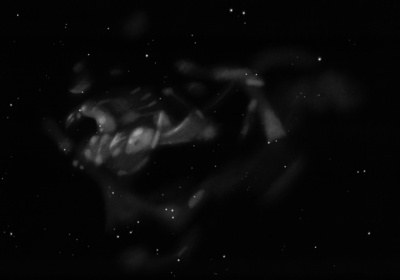Checkmark Nebula,Lobster Nebula,Swan Nebula,omega Nebula
Checkmark Nebula,Lobster Nebula,Swan Nebula,omega Nebula

Philippe Loys De Chéseaux discovered M17 = NGC 6618 = h2208 in 1745-46 from Paris and wrote, "It has perfectly the form of a ray, or of the tail of a comet, of 7' length and 2' broad; its sides are exactly parallel and rather well terminated, as are its two ends. Its middle is whiter than the borders. Charles Messier rediscovered M17 on 3 Jun 1764 and described "a train of light without stars, 5' or 6' in extent, in the shape of a spindle, a little like that in Andromeda's belt, but the light is very faint..."
William Herschel, using his small 20-ft (12-inch aperture) telescope on 2 Aug 1783, called M17 "a curious train of light. I cannot resolve it." On 27 Jun 1786 (sweep 576) he logged "an extensive milky nebulosity of more than 20' in length, with a hook to the preceding side, bended towards the south; the extent is from np to sf and looses itself imperceptibly. The hook includes a dark place, almost resembling that in the nebula of Orion."
On 6 Aug 1823 (sweep 48), John Herschel recorded "A large extended nebula. Its form is that of a Greek Omega with the left (or following) base-line turned upwards. The curved (or horse-shoe) part is very F, and has many stars in it. The preceding base-line hardly visible. The following, which is the principle branch, occupies nearly half the field (7 1/2'). Its light is not equable, but blotty. Strong twilight." He didn't describe the nebula from the Cape of Good Hope, but his published sketch (plate II, figure 1) shows from 1837 shows a second curve at the east end, hooking north. Based on the sketch, Dreyer referred to M17 as "2-hooked" in the NGC, an odd description.
200/250mm - 8" (7/16/82): very bright, large, very detailed. The brightest portion consists of a long bright ray that hooks south at the west end. A fainter section oriented N-S section follows. The main bar is mottled. The irregular hooked portion is clearly mixed with a dark nebula intruding. Fainter nebulosity is visible north and south of the main bar.
300/350mm - 13.1" (7/16/82): the "Swan Nebula" is very bright, very large, with fantastic detail along the bright bar. Has a turbulent texture with dark areas near the "hook". A nebulous halo surrounds the brighter star to the south.
Notes by Steve Gottlieb